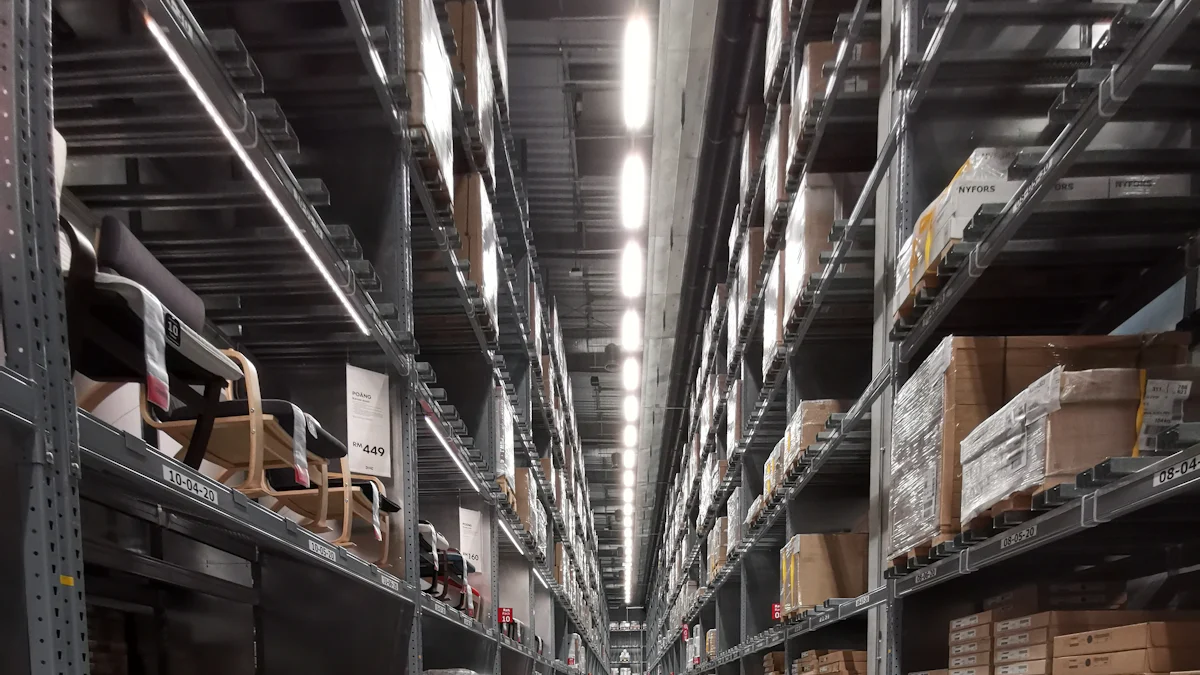Application of inventory control strategies in modern warehouse management

Inventory control plays a vital role in warehouse management. Effective inventory management impacts a company’s profitability and overall financial health. Supply chain analysts focus on improving inventory control to balance supply and demand. Reducing stock-outs and overstocks can lower inventory costs by 10%. Modern warehouses face challenges like fluctuating consumer demands and complex logistics. Advanced strategies, such as ABC analysis, provide tailored approaches to inventory control. Technologies like RFIDs enhance communication and information-sharing processes. These innovations improve the performance of the entire supply chain, from the origin point to the end user. Lagerverwaltung remains essential for maintaining optimal stock levels.
Understanding Inventory Control Strategies
Definition and Importance
What are inventory control strategies?
Inventory control strategies involve methods to manage stock levels efficiently. These strategies determine the optimal quantity of products to order and store. Businesses use these methods to ensure that supply meets demand without excess or shortage. Effective inventory control optimizes fulfillment and reduces handling costs.
Why are they crucial for warehouse management?
Warehouse management relies on inventory control strategies to maintain operational efficiency. Proper strategies improve customer experience by ensuring product availability. Businesses can enhance profitability by reducing unnecessary storage costs. Inventory control also aids in tracking sales and planning forward.
Types of Inventory Control Strategies
Just-In-Time (JIT)
Just-In-Time (JIT) strategy minimizes inventory levels by receiving goods only as needed. This approach reduces storage costs and minimizes waste. JIT requires precise demand forecasting and efficient supplier relationships. Businesses using JIT often see improved cash flow and reduced inventory holding costs.
Economic Order Quantity (EOQ)
Economic Order Quantity (EOQ) calculates the optimal order size to minimize total inventory costs. This strategy balances ordering costs with holding costs. EOQ helps businesses avoid overstocking and stockouts. Companies using EOQ benefit from cost-efficient inventory management.
ABC Analysis
ABC Analysis categorizes inventory into three groups based on importance. Group A includes high-value items with low sales frequency. Group B consists of moderate value items with moderate sales frequency. Group C contains low-value items with high sales frequency. This method allows for tailored inventory control, leading to better stock management and increased turnover.
Safety Stock Management
Safety Stock Management involves maintaining extra inventory to prevent stockouts. This strategy acts as a buffer against demand fluctuations and supply chain disruptions. Businesses using safety stock can ensure continuous product availability. Proper safety stock levels improve customer satisfaction and reduce the risk of lost sales.
Modern Warehouse Management Practices
Integration of Technology
Role of Warehouse Management Systems (WMS)
Warehouse Management Systems (WMS) revolutionize inventory control. These systems provide real-time data on stock levels. Managers use WMS to optimize storage space and improve order accuracy. The system tracks goods from arrival to dispatch. Companies achieve higher efficiency with WMS. The technology reduces manual errors and enhances productivity.
Use of RFID and Barcode Scanning
RFID and barcode scanning enhance warehouse operations. These technologies offer precise tracking of inventory. Workers scan barcodes to update stock levels instantly. RFID tags allow for automatic identification of items. This method speeds up the receiving and shipping processes. Businesses experience fewer stock discrepancies with these tools. The technology ensures accurate and timely data collection.
Automation in Warehousing
Automated Storage and Retrieval Systems (AS/RS)
Automated Storage and Retrieval Systems (AS/RS) transform warehousing. These systems use machines to store and retrieve goods. AS/RS increases storage density and reduces labor costs. The technology minimizes human intervention in routine tasks. Companies see a 250% increase in total productivity with AS/RS. The system also leads to 20% cost savings for businesses.
Robotics and Drones in Warehousing
Robotics and drones redefine modern warehouses. Robots handle repetitive tasks like sorting and packing. Drones conduct inventory checks and monitor stock levels. These technologies reduce the need for manual labor. Warehouses experience a 30% decrease in project timelines with automation. Robotics and drones enhance user engagement by 40%. The innovations provide 100% indemnity relief for late deliveries.
Application of Inventory Control Strategies in Modern Warehouses

JUSDA's Approach to Lagerverwaltung
JusLink Platform and its role in inventory management
JUSDA employs the JusLink platform for effective inventory management. The platform integrates advanced technologies like big data and IoT. JusLink provides real-time visibility into supply chain operations. This system enhances decision-making by offering precise data analysis. JusLink optimizes resource utilization and improves business efficiency. The platform supports seamless collaboration among suppliers, manufacturers, and customers.
Cloud Warehouse Services and their impact on efficiency
JUSDA's cloud warehouse services revolutionize inventory control. These services offer integrated solutions for multi-channel sales. Businesses achieve automated warehousing through a big data platform. The cloud warehouse supports Vendor Managed Inventory (VMI) and Customer Managed Inventory (CMI). This approach ensures efficient stock management and reduces operational costs. JUSDA's cloud services enhance logistics performance and reliability.

SMART JusLink
Supply Chain Management Solution
Case Studies and Examples
Successful implementation of JIT in a retail warehouse
A leading retail warehouse implemented Just-In-Time (JIT) strategy. The warehouse reduced inventory levels significantly. JIT minimized storage costs and improved cash flow. Precise demand forecasting ensured timely product availability. The retail warehouse experienced increased customer satisfaction. JIT enhanced overall operational efficiency.
EOQ application in manufacturing warehouses
A manufacturing warehouse adopted Economic Order Quantity (EOQ) strategy. The warehouse optimized order sizes to minimize costs. EOQ balanced ordering and holding expenses effectively. The strategy prevented overstocking and stockouts. The manufacturing warehouse achieved cost-efficient inventory management. EOQ contributed to improved profitability and resource allocation.
Benefits and Challenges
Improved efficiency and reduced costs
Inventory control strategies enhance warehouse efficiency. Businesses experience reduced storage and handling costs. Optimized stock levels prevent excess inventory and waste. Companies achieve better cash flow and resource utilization. Inventory control strategies improve customer satisfaction and service quality.
Challenges in implementation and how to overcome them
Implementing inventory control strategies presents challenges. Businesses face difficulties in demand forecasting and supplier coordination. Technology integration requires significant investment and expertise. Companies must train staff to adapt to new systems and processes. Overcoming these challenges involves strategic planning and continuous improvement. Businesses should leverage data analytics for informed decision-making.
Problem-Solution Approach in Inventory Management
Common Challenges in Inventory Management
Overstocking and Stockouts
Overstocking and stockouts present significant challenges in inventory management. Overstocking ties up capital and increases storage costs. Stockouts lead to lost sales and customer dissatisfaction. Both scenarios disrupt the supply chain and affect business performance. Managing inventory levels effectively requires a strategic approach.
Inefficient Order Processing
Inefficient order processing hinders warehouse operations. Manual processes often result in errors and delays. Human error accounts for 62% of problems in inventory fulfillment. Delays in order processing impact customer satisfaction. Businesses need efficient systems to streamline order processing.
Solutions and Best Practices
Implementing Real-time Inventory Tracking
Real-time inventory tracking enhances visibility and control. Businesses monitor stock levels accurately with technology. Real-time inventory tracking prevents overstocking and stockouts. Companies achieve better inventory balance and reduce unnecessary costs. Real-time tracking improves shipping and delivery timelines.
Optimizing Reorder Points and Quantities
Optimizing reorder points and quantities ensures efficient inventory management. Businesses calculate optimal reorder points based on demand patterns. Accurate reorder quantities prevent excess inventory and shortages. Companies enhance cash flow and resource allocation with optimized orders. This practice improves customer satisfaction and service quality.
Inventory control strategies hold immense importance in modern warehouse management. Effective techniques enhance business performance by improving customer service and controlling expenses. Companies can optimize operations and reduce costs through strategic inventory management. Efficient practices prevent excess stock and additional storage costs. Businesses benefit from improved cash flow and increased manufacturer efficiency. The future of warehouse management will rely on advanced technologies and data-driven strategies. Companies must adopt best practices to navigate challenges and achieve success.
See Also
Maximize Business Potential with Cutting-Edge Inventory Strategies
Enhanced Efficiency: Demystifying Robotics in Warehouse Operations
Logistics Robotics Dominance: Elevating Warehouse Efficiency
Automated Tomorrow: Benefits of High-Tech Manufacturing Warehouses
